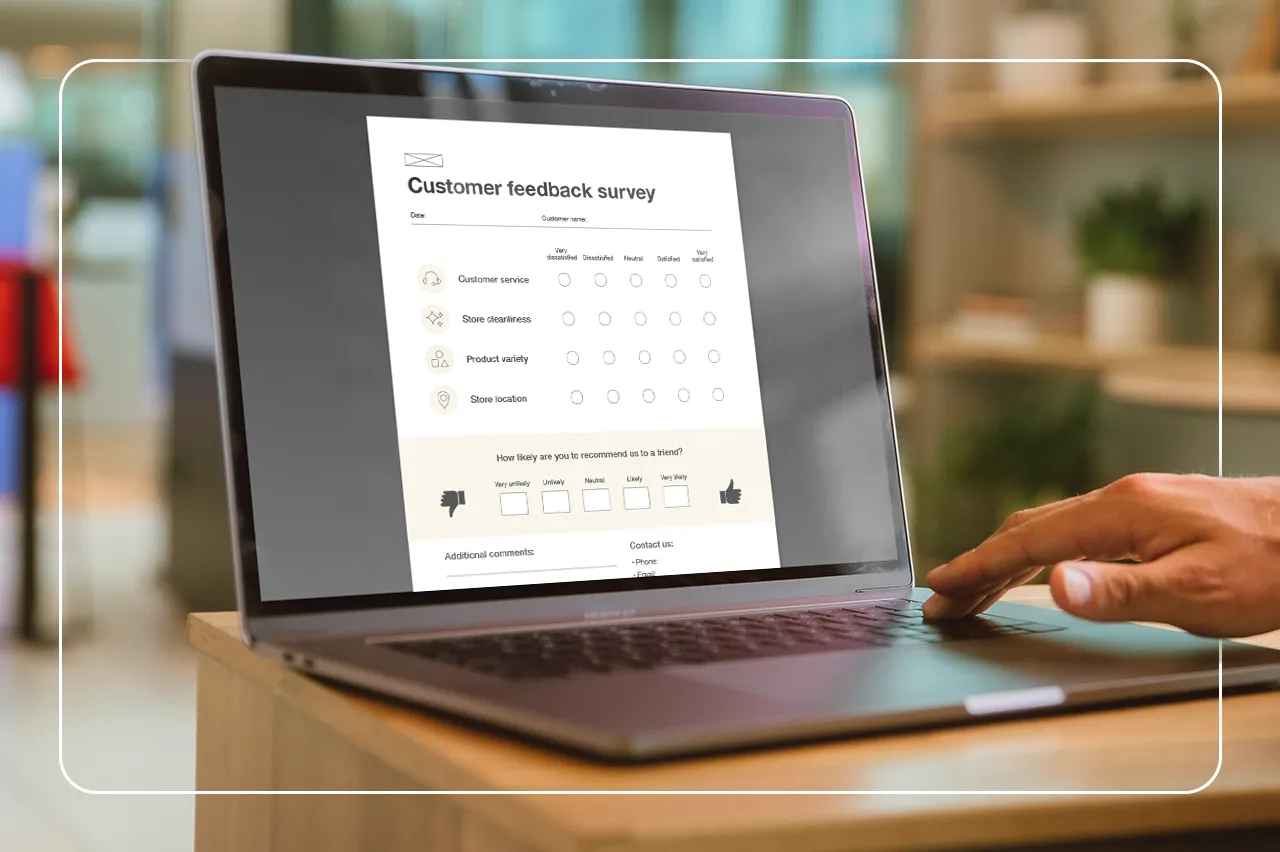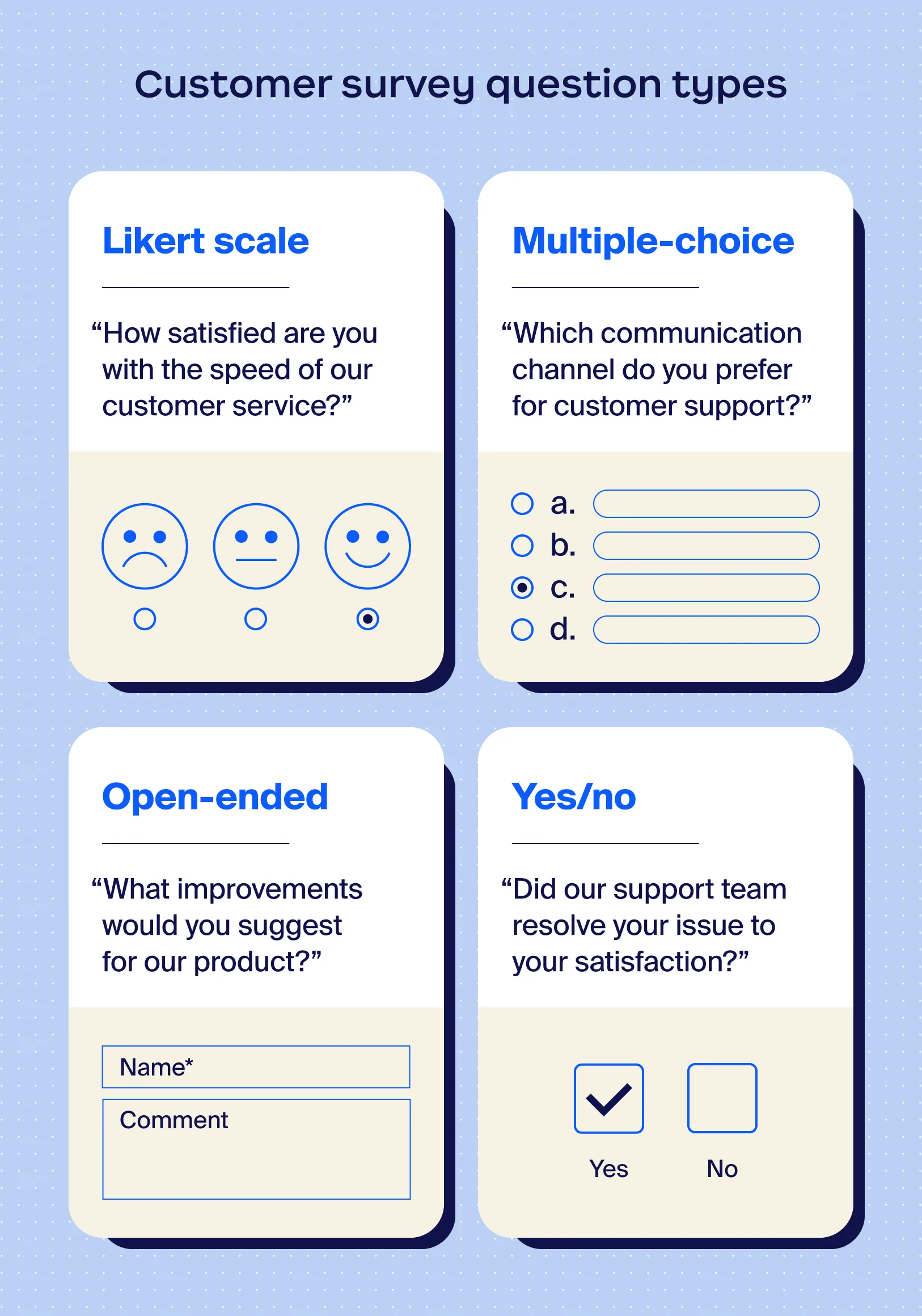
Meet Zoom AI Companion, your new AI assistant!
Boost productivity and team collaboration with Zoom AI Companion, available at no additional cost with eligible paid Zoom plans.
Updated on September 30, 2025
Published on September 30, 2025


Customer service surveys are your go-to tool for uncovering what your customers really think about your service. These surveys aren't just about collecting feedback; they also show your customers that their opinions matter, making them feel valued and appreciated. When customers see that you’re listening, their loyalty and trust in your brand grow stronger. Plus, the insights you gain from these surveys can lead to smarter, customer-focused decisions that boost satisfaction and drive success.
Whether you’re a business owner, manager, or team leader, we’ll walk you through some of the most effective customer service survey questions to collect valuable feedback and help you satisfy your customers.
Customer service survey questions are carefully crafted inquiries designed to gather feedback from customers about their experiences with your service. These questions can cover various aspects of the customer journey, from the ease of connecting with a customer service representative to the quality of support received. The primary purpose of these surveys is to measure customer satisfaction, understand customer preferences, and identify areas for improvement.
With customer service surveys, businesses can gain valuable insights into what their customers think and feel — including frustrations with current processes and ideas for improvement — which can guide strategic decisions to improve service quality.
CSAT scores measure customer satisfaction with a company’s products, services, and customer support. In a CSAT survey, a customer scores their experience out of 5 or 10:
| Opinion | Out of 5 | Out of 10 |
| Very satisfied | 5 | 9-10 |
| Satisfied | 4 | 7-8 |
| Neutral | 3 | 5-6 |
| Unsatisfied | 2 | 3-4 |
| Very unsatisfied | 1 | 1-2 |
Use this calculation to work out your CSAT score:
| (Number of satisfied responses / Total number of responses) x 100 = CSAT |
Note that “satisfied responses” refers to a 4 or 5 score out of 5 or a 7-10 score out of 10. So, if you had 25 responses and 10 either rated you as a 4 or 5, your CSAT score would be 40%.
CSAT scores allow you to track customer satisfaction levels over time, but they have limitations. They only tell you if someone is happy or unhappy, not why they feel that way.
If your score drops, follow up with more detailed customer satisfaction surveys, especially targeting those who gave low ratings. Act on the answers you receive to prevent churn, build back consumer trust, and uncover ways to improve your overall performance.
By understanding what your customers think and feel, you can make informed decisions that improve your products, services, and overall customer experience.
Listening to your customers can reveal what they love about your offerings and what they think could be better. Use these insights to innovate and develop products or services that truly meet their needs. Whether it’s adding new features, improving usability, or launching entirely new products, customer feedback questionnaires can guide you in the right direction so you’re always aligned with your customers’ expectations.
Did you know that responding to customer feedback can seriously boost loyalty? When customers see that you’re listening and taking action based on their opinions, they can feel more connected to your brand. It’s a great way to turn one-time buyers into repeat customers.
Negative feedback might not feel good at first, but it’s actually one of the most valuable things your business can receive. By addressing issues quickly and effectively, you can turn unhappy customers into loyal fans. Personalize your follow-ups, offer solutions or compensations, and show you genuinely care about their experience. This approach not only helps you keep customers but also makes them feel valued and satisfied.3. Informing marketing and sales strategies
Customer feedback is a great source of information for your marketing and sales strategies. By understanding what your customers want and need, you can tailor your marketing messages and sales approaches to hit the mark every time.
For example, if feedback shows that customers love a specific product feature, highlight that in your marketing campaigns. Or, if they prefer a certain communication channel, focus your sales efforts there. Businesses that adapt their strategies based on customer preferences and feedback often see better engagement and increased sales.
Staying ahead of market trends can be challenging, but ongoing customer feedback makes it easier.
If you notice trends in customer preferences or new needs emerging, you can proactively adjust your strategies. For instance, if feedback reveals a growing interest in sustainability, you might tweak your product offerings or marketing to highlight existing eco-friendly features. Businesses that use customer insights to guide their adjustments are better positioned to stay relevant and competitive in a constantly changing landscape.
Listening to what customers are saying and making positive changes reflects well on your company. People love to see a brand that genuinely cares and evolves based on their needs.
Encouraging customers to share their positive experiences publicly can also enhance your reputation. Highlight and share these positive reviews on your website and social media to show off your great customer experiences. Happy and satisfied customers are your best advocates, and their positive words can strengthen your brand’s image.
Getting the right feedback from your customers starts with asking the right questions. Here are effective customer service survey question examples that can provide valuable insights and help you enhance your business.

 Customer loyalty questions
Customer loyalty questions1. How often do you use our product or service?
2. How likely are you to continue using our product or service in the future?
3. On a scale of 1-10, how would you rate your overall satisfaction with our product or service?
4. What factors influence your decision to continue using our product or service?
5. Would you recommend our product or service to others?
6. How would you describe your experience with our customer service?
7. What could we do to improve your experience with our product or service?
8. How does our product or service compare to competitors you’ve used?
9. What would make you more likely to choose us over other options in the future?
10. What made you choose our product or service over other options?
11. If someone asked you about our product or service, what would you say you like and where do we need to do better?
12. How old are you?
13. What is your gender?
14. What is your highest level of education?
15. What is your occupation?
16. What is your income level?
17. What country do you live in?
18. What type of device do you primarily use to access our product or service?
19. How easy is it to use our product/service?
20. How well does our product/service meet your needs?
21. How reliable is our product/service in your experience?
22. Which feature of our product/service do you find most valuable?
23. Are there any product/service features you feel are missing or need improvement?
24. How would you rate the performance of our product/service?
25. How does the ease of use of our product/service compare to similar products/services you’ve used?
26. How would you rate our product or service on value for money?
27. What additional features would you like to see added to our product/service?
28. How satisfied are you with the speed at which our customer support team responded to your initial contact?
29. How aware are you of the use of AI in your customer support experience?
30. How happy are you with the use of AI to help resolve your issue?
31. Would you like more information about the use of AI in our customer support?
32. How effectively did our customer support team resolve the specific issue or inquiry you had?
33. How would you rate the level of politeness demonstrated by our support representatives during your interaction?
34. How professional did you find the demeanor and communication skills of our customer support representatives?
35. How clear and detailed was the information provided by our support team to address your issue or question?
36. How easy was it for you to reach our customer support team through your preferred contact method (phone, email, chat)?
37. How satisfied were you with the follow-up communications from our customer support team after your initial issue was addressed?
38. How well did our customer support team understand the details of your issue or question and provide relevant solutions?
39. How would you rate the customer support for issues related to our product/service?
40. Overall, how satisfied are you with the customer support experience, including resolution and interaction?
41. Are there any customer support channels we’re not currently using that you’d like us to add?
42. What improvements would you suggest for our customer support service?
43. How easy was the purchasing process for our product or service?
44. How would you rate the clarity of information provided during the purchase process (pricing, terms, product details)?
45. How satisfied were you with the delivery time of your purchase?
46. How would you rate the condition of the product upon delivery?
47. If applicable, how satisfied were you with the installation process of your product?
48. How well did the delivery or installation team communicate with you regarding the schedule and any issues?
49. How satisfied are you with the post-sale support or follow-up provided after your purchase?
50. How effectively did our customer support team address any post-purchase issues or questions you had?
51. How satisfied were you with the ease of returning or exchanging the product if necessary?
52. When you first started using our service, how would you rate the setup procedure?
53. Are you happy with the breadth of information in the knowledge base on our website?
54. How easy was it to navigate through our website or app to find what you needed?
55. How intuitive did you find the layout and design of our website or app?
56. How clear and understandable was the information provided about our product or service on the website or app?
57. How would you rate the overall user interface of our website or app?
58. How satisfied are you with the visual design and aesthetics of our website or app?
59. How effective are the search and filtering options on our website or app in helping you find relevant information?
60. How would you rate the speed and performance of our website or app during your use?
61. How satisfied are you with the responsiveness of our mobile app?
62. How helpful is the on-site FAQ in assisting you with navigation or issues?
63. Overall, how satisfied are you with your user experience on our website or app?
64. When you log in, how helpful are the on-screen prompts and tooltips in explaining how certain features work?
65. How likely are you to recommend our products and services to others?
66. How satisfied are you with the support provided through email?
67. How effective was our live chat support in resolving your issue or answering your questions?
68. How would you rate the quality of assistance received through phone support?
69. How satisfied are you with our email support's response time?
70. How effective was our phone support in addressing your concerns?
71. Which communication channel (email, live chat, phone) do you prefer for customer support and why?
72. How well did our support team communicate through your preferred channel?
73. How satisfied are you with the availability of support through your preferred communication channel?
74. Based on your past experiences, how likely are you to use the different communication channels (like email)?
75. Are there any channels where you find the quality of customer interactions better or worse than others?
76. If one support channel is unavailable, how willing are you to switch to another?
When crafting customer surveys, the type of questions you ask impacts the quality and usefulness of the feedback you receive. Different types of questions serve different purposes and can help you gather various insights.
Below, find out more about four of the most popular types of survey questions when collecting customer feedback:
Best for: Measuring attitudes and opinions
Likert scale questions, like those used for CSAT and NPS scores, are great for measuring attitudes or opinions on a scale, typically from “Strongly Disagree” to “Strongly Agree.” This type of question allows respondents to express the intensity of their feelings about a statement, providing nuanced insights into their views.
Example: You might ask, “How satisfied are you with the speed of our customer service?” with a scale ranging from 1 (very dissatisfied) to 5 (very satisfied).
Best for: Choosing one option from a list
Multiple-choice questions offer respondents a set of predefined options to choose from. This type of question is useful for collecting specific information or understanding preferences across a defined set of choices. Multiple-choice questions are easy to analyze and can reveal clear trends and preferences.
Example: Ask, “Which communication channel do you prefer for customer support?” with options like Email, Live Chat, and Phone.
Best for: Gathering detailed, qualitative insights
Open-text field questions allow respondents to provide detailed, qualitative feedback in their own words. This type of question is valuable for capturing in-depth opinions, suggestions, or experiences that predefined options might not cover. This format provides rich, detailed insights, but can be more challenging to analyze due to the variety of responses.
Example: You could ask, “What improvements would you suggest for our product?” to obtain an in-depth response from your customer.
Best for: Getting a clear, binary answer
Yes/No questions are straightforward and useful for gathering clear, binary feedback. They are ideal for questions where you need a simple affirmative or negative response. While these questions are easy to answer and analyze, they may not capture the full context or nuances of a respondent’s experience.
Example: A question like, “Did our support team resolve your issue to your satisfaction?” provides a quick way to assess whether a specific aspect of your service meets expectations.

Getting meaningful feedback from your customers can be a game-changer, but how you go about it makes all the difference. Here are some best practices to keep in mind to make your surveys effective and engaging:
Beyond direct surveys, businesses can also analyze interactions to improve service quality. Call center voice analytics help supervisors identify opportunities for agent training and de-escalate difficult customer conversations in real time.
Picking the right method for your surveys can make a big difference in how many customers respond to them and the depth of insights you get. Here’s a quick guide to help you decide:
Timing your surveys right is crucial because it helps you gather feedback when it’s most relevant and fresh. Let’s look at some survey questions to capture accurate insights into customer engagement:
Set up customer service automation workflows to send out surveys and questionnaires at the right moments in the customer journey to capture timely, actionable feedback.
To truly excel in customer service, you have to leverage the right tools and strategies. Zoom CX with AI Companion helps you seamlessly integrate customer feedback into your operations, driving improvements and enhancing satisfaction. With the insights gathered from customer service survey questions, you can fine-tune your approach and foster lasting customer relationships.
Ready to elevate your customer service? Explore how Zoom Contact Center within the Zoom CX suite can transform your support experience.